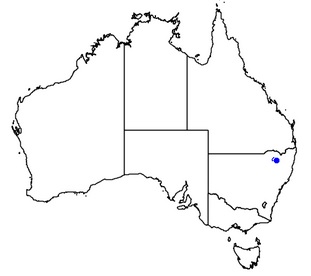Acacia atrox
| center|100x100px | This species is classified RARE. DO NOT harvest this species! |
|---|---|
Contents
General Plant Info
Acacia atrox, a new species also provisionally listed as Acacia sp. ‘Myall Creek’, does not appear to have any particularly close relatives, but may have some affinities with Acacia carneorum from which it is readily distinguished by its glabrous branchlets, pale-coloured flower-heads and especially by its phyllodes. The phyllodes are perhaps the most distinctive feature of these plants, where the base of their phyllodes are conspicuously splayed, a most unusual (but not unique) character for an Acacia
Acacia atrox is restricted to the Inverell region on the North Western Slopes of New South Wales and is provisionally listed as an endangered species, requiring planning and management for its conservation.
Fowers recorded in May and July. No pod formation was observed during latter stages of flowering in mid-July 2000 (Hawes et al. 2000) and no pods were found in early November 2000 (T. Tame, pers. comm.). Although A. atrox has often been seen in flower in past years, pods have not been observed (W. Pollock, pers. comm.) and it is possible that they are rarely, if ever, produced
More information is required on its biology and ecology, including reproduction strategies and life cycles.
Consists of 2 subspecies:
Acacia atrox subsp. planiticola
Geographic distribution
Known only from a single collection site on Myall Creek Station, 18 km S of Delungra, west of Inverell, North Western Slopes, New South Wales.
Identification
Dense, much branched shrub normally 0.5–1.5 (–2) m high, oldest plants to 4 m high.
Bark grey-brown, becoming dark grey and vertically fissured with age.
Branchlets terete, pale green and slightly pruinose to pale yellowish green when dry, occasionally with a pinkish tinge when young, sometimes becoming encrusted with a brownish to blackish material with age, glabrous, with very low rounded ridges; axillary branchlets subtended by two caducous bracts (which usually leave fine scars on the stem when shed).
Phyllodes sessile, patent to slightly inclined, ± straight, ± quadrangular in section (to ± terete), with a yellow or pale-coloured vein at apex of each angle and a less prominent vein on the intervening faces (± 8-veined altogether, however, the intermediate veins are often incomplete not reaching the apex, obscure, wrinkle-like or not apparent, hence the phyllodes often appearing c. 4-veined), (1.5–) 2–4 (–4.5) cm long, 1–1.2 (–1.3) mm wide, rigid, light green (dry), glabrous (immature phyllodes with scattered, appressed, white-hyaline hairs), gradually tapered towards a pungent-pointed apex (the fine tip orange-brown and 1.5–3.5 mm long), abruptly broadened or splayed at base 2–6 mm wide (leaving an oval-obovate scar on branchlet when lost), with a small ± circular gland on upper margin or vein near (or to 3 mm above) base and often a second minute gland c. ⅓–⅔from base; galls with a shape that is hakea fruit-like are commonly formed within some phyllodes.
Inflorescences normally paired (often one of the peduncles missing) or sometimes single on a rudimentary raceme axis to 1 mm long (often appearing simple); peduncles 5–21 mm long, glabrous; bracts at base of peduncles deeply convex, ± broadly ovate, often with a split or minor lobe/peak about midway below either side of the apex, to 2 mm long, sparsely ciliolate, often caducous; heads globular, 17–25-flowered, 5–7 mm diam. (dry), cream-coloured to pale yellow. Bracteoles ± obovate to broadly spathulate, 0.9–1.1 mm long, ciliolate, with scattered minute hairs also on the outer surface of the claw especially along midline (which is often not central). Flowers 5-merous; calyx cupular, 0.8–1.2 mm long, dissected for ¼(–⅓) or less, with minute hyaline-white hairs at base and often scattered on tube or concentrated along ribs, ciliolate along the obtuse to broadly rounded lobes; corolla dissected for ⅓–½or more, probably splitting towards base with age, the petals 1.5–1.9 mm long, 1-veined, glabrous or with inconspicuous, minute hairs or granules at apex mainly on margin, acute and often purplish in upper half; ovary glabrous to white-puberulous.
Pods and seeds unknown.
Alkaloid content
Other uses
Extraction
Cultivation
Grows in deep clay soils, on basalt
Suppliers
Links
https://www.rbgsyd.nsw.gov.au/__data/assets/pdf_file/0008/72809/Tel9Kod415.pdf
